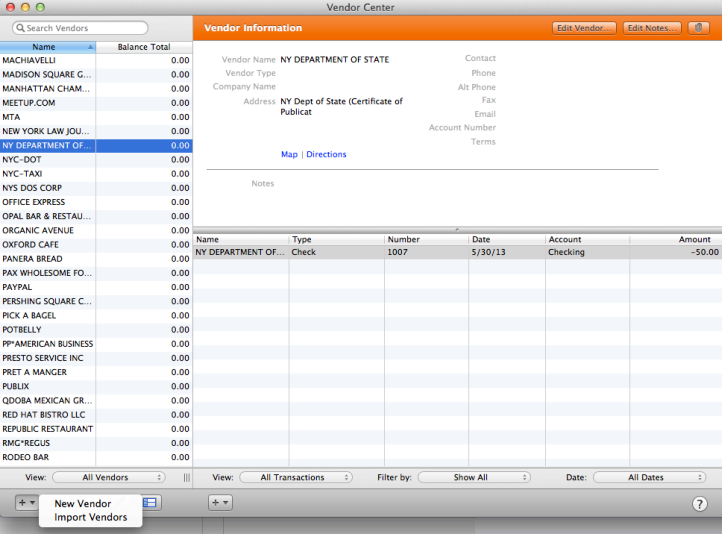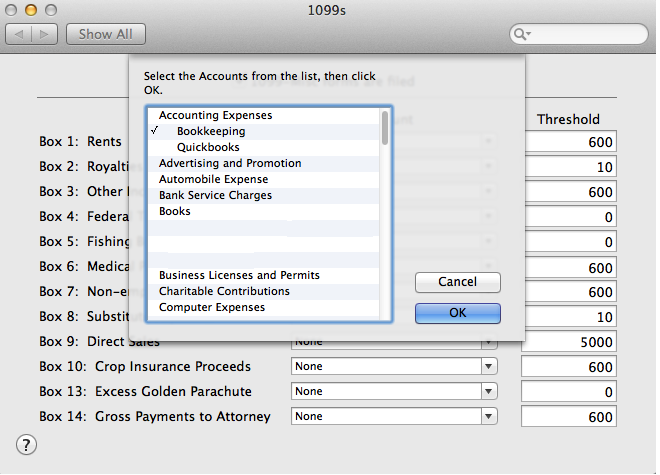

- #1099 ACCOUNTS QUICKBOOKS FOR MAC HOW TO#
- #1099 ACCOUNTS QUICKBOOKS FOR MAC FOR MAC#
- #1099 ACCOUNTS QUICKBOOKS FOR MAC MAC#
#1099 ACCOUNTS QUICKBOOKS FOR MAC HOW TO#
Now that we have the simple “Sales Tax Adjustment” function, it’s easy enough to adjust sales tax payable that we can show our clients how to do it. The toughest part of fixing the errors usually isn’t the mechanics of entering an adjustment it’s figuring out what amount and date of the adjustment should be. Once you’ve found your discrepancies, the hardest work is done. If your client pays sales tax on deposits/pre-payments and tracks them as a liability, use the Sales by Item Detail report in addition to the Profit and Loss report. Map sales Items to Income, and not Other Income, accounts. What to do about it: Create a Credit Memo for sales discounts instead of using Receive Payments. What to know: Sales Discounts applied during Receive Payments and Items mapped to Other Income Accounts and Balance Sheet accounts, will not be included in the Total Sales on the Sales Tax Liability report.

In this example, “Less Discounts Given” (-$720.00) and Other Income ($58.39) are not on the Sales Tax Liability report. Any differences will point you to the errors on the Sales Tax Liability, except Cost of Goods Sold. Now, compare the Total Income on the filtered Profit and Loss report to the unfiltered report. Click “Apply” in the next window to create the filtered report.ĥ. Click “OK” to complete the Filter settings. Choose “Selected Transaction Types”, and then chose Invoice Sales Receipt and Credit Memo.Ĥ. Choose the filter “Transaction Type” near the bottom of the Filter options to engage the Transaction Type filter.ģ. Click the “Filters” icon at the top left of the report Toolbar.Ģ. Partial payments are applied to sales tax in equal proportion to other Items on the Invoice.ġ. Any differences will point you to the errors on the Sales Tax Liability.ĮXPERT TIP: The date on the Receive Payment, not the date on the Make Deposit or the Invoice, is the date that the sales tax liability will be impacted on cash basis. If the reporting basis or the dates are not the reason your Profit and Loss does not match your Sales Tax Liability report, create another Profit and Loss report and filter it for income transactions and compare it to the unfiltered Profit and Loss report. If they aren’t the same, make sure the dates and the reporting basis on the Profit and Loss report matches that of the Sales Tax Liability report.ĮXPERT TIP: To set the reporting basis for the Sales Tax Liability report, go to QuickBooks > Preferences > Sales Tax

The Total Income on both of these reports should the same. Start by creating both a Sales Tax Liability and a Profit and Loss report.

#1099 ACCOUNTS QUICKBOOKS FOR MAC MAC#
Spoiler alert: starting with QuickBooks Mac 2014, you can use the same “Adjust Sales Tax Due” feature that’s been available in Windows for years. Here, we have provided a step-by-step guide for finding sales tax errors and our advice for fixing them. For others, the conversion to QuickBooks for Windows is successful and provides reports not available in QuickBooks for Mac, but finding the problem provides little relief if fixing it in Windows or Mac is not an option. Some of us – determined to track down those nagging discrepancies – turn to “round-tripping” (converting the file from Mac to Windows and back to Mac) only to find the data scrambled in the process.
#1099 ACCOUNTS QUICKBOOKS FOR MAC FOR MAC#
Of all the areas that QuickBooks ® for Mac consultants struggle with, finding and fixing sales tax errors is one of the toughest because we can’t get the detailed reports our Windows’ counterparts have access to within the software.


 0 kommentar(er)
0 kommentar(er)
